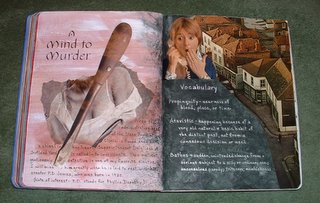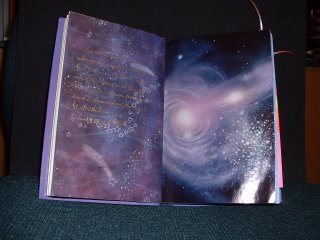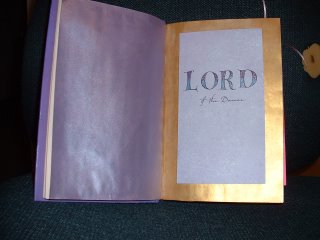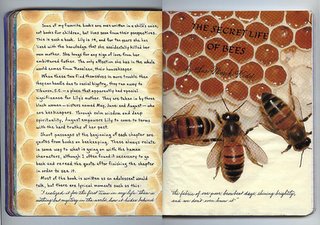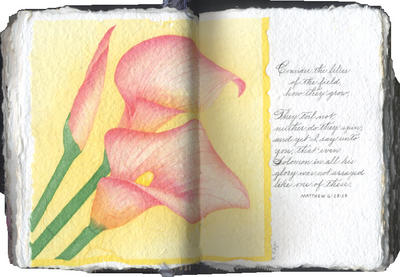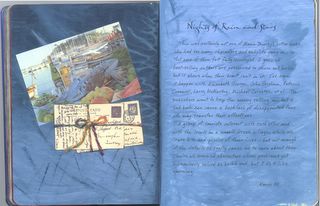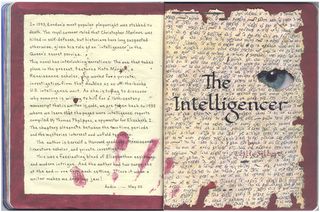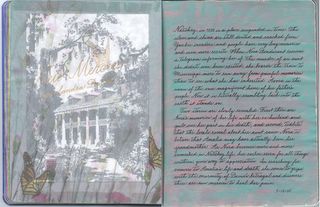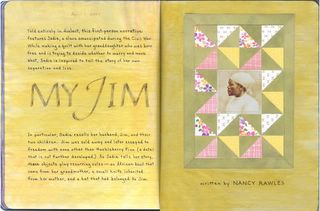This is the cover of a book that I made in a class this past weekend. Sharon Zeugin was the instructor, and she showed us this technique which she learned from Thomas Ingmire, who had learned it from a Japanese man.
Here's how:
1. Fold 3 signatures in half. I used 3 sheets of Arches Text Wove per signature, each 10"x13".
2. Take 2 cover sheets that are the same size as your unfolded pages. Fold each of these about 1" from one of the shorter sides. I used pieces of paste paper from Arches Text Wove that I had made in a class taught by Rosie Kelly.
3. Place the last signature inside the fold of the back cover. Lay the middle signature on top of the cover's flap. Place the first signature inside the fold of the front cover, and lay the flap side down on top of the middle signature.
4. Jog the spine to align all the signatures and clip everything together.
5. Come down about 1" from the top and lay two fingers across the spine. Mark with a pencil on either side of your fingers. Repeat at the bottom of the spine.
6. Use an X-acto knife to score the pencil marks across all layers.
7. Remove the clips and slice individual sections at score marks about 1/8" deep with the knife. Check to be sure it cuts through to the center page. Take care to keep the signatures in order.
8. Measure 2 pieces of waxed linen thread, each 2 1/2 times the length of the spine. (Heavily-waxed thread will help hold the needles in place when they're dangling as you work.)
9. Place a tapestry needle on each end of each thread, for a total of 4 needles.
10. Push needles from one thread through the 2 holes at the top of the first signature, coming from inside the fold. Repeat at the bottom holes with the other thread & needles. Try to keep the ends of the threads equidistant.
11. Attach the middle signature by sewing from outside of fold to inside. Then cross each pair of needles over and out their partner's hole to come back to the outside. Be sure your stitches are taut.
12. Attach the last signature & back cover by pushing needles from the outside to the inside. Tie the top 2 threads together with a square knot (rt. over lt & lt. over rt.), placing the knot over the hole that is nearer to the middle. Repeat with the bottom threads. Pull the threads perpendicular to the spine as you tighten them.
13. Take the bottom needles and lace under the top stitch, bringing each one underneath from opposite directions. Tighten and tie off in a square knot. Trim ends about 1/4" from knot. Repeat with other needles.
14. Score the cover extensions about 1/8" beyond the pages and fold toward the spine. You can glue the cover extensions at the top and bottom edges to form pockets, or leave them free to serve as book markers. By scoring the back one a bit further away, you can wrap it around and over the front cover, where it can be secured with a ribbon, a paper belt, a button/string closure, etc.
This makes a very sturdy book, and is fast and easy to do. You can add more signatures, attaching them as in Step 11. Try using 2 different colors of thread. Make different sizes. Vary the color of your pages. Mix the types of paper (try adding some mulberry or lace paper.) Attach ephemera to the inside flaps with glue, brads, grommets, or thread (a good place to dangle some beads!)
